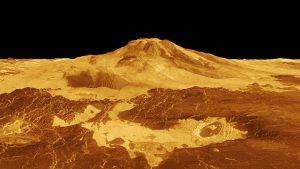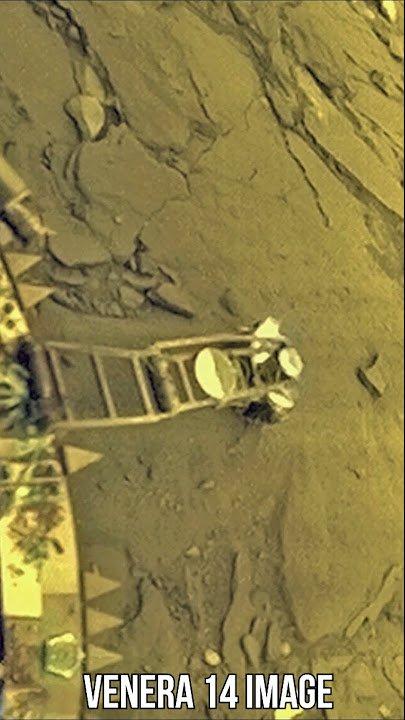“The First and Only Photos From Venus – What Did We See (And Hear)?” takes you on a journey to the surface of Venus, a planet that poses significant challenges for spacecraft. With its blistering heat and crushing pressures, Venus has destroyed numerous landers, making it difficult to capture images. However, in 1975 and 1982, the Soviet Union’s Venera probes managed to capture photos of Venus’ surface, revealing a landscape that is both alien and familiar. These images show yellow skies and cracked, desolate landscapes, painting a picture of a world that may have once resembled Earth before experiencing catastrophic climate change. Tune in to witness these extraordinary photos that provide a rare glimpse into the enigmatic surface of Venus.
Landing on Venus is no easy feat. Below the perpetually shrouded thick toxic clouds lies a surface where temperatures reach a scorching 475 degrees Celsius (900 degrees Fahrenheit), making it the hottest planet in the solar system. In addition to the extreme heat, Venus’ atmosphere exerts a crushing air pressure over 90 times that of Earth’s. However, the Venera landers were ingeniously designed to withstand these extreme conditions long enough to capture and transmit data from the surface of Venus. Discover the fascinating engineering behind these groundbreaking probes and delve into the challenges of capturing photographs in such a hellish environment.”
The First Photos From Venus
Table of Contents
In the vast realm of our solar system, Venus has always been an enticing yet enigmatic celestial body. Its thick atmosphere and extreme temperatures made it a challenging target for exploration and left scientists with countless unanswered questions. However, the Venera probes, developed during the space race between the Soviet Union and the United States, aimed to unlock the secrets of this mysterious planet. These ambitious missions not only provided us with the first photos from Venus but also shed light on the immense challenges of landing on its treacherous surface.
Overview of the Venera Probes
The Venera program, initiated in the early 1960s, was a series of unmanned missions conducted by the Soviet space agency, Roscosmos, with the objective of exploring Venus. The program spanned approximately two decades and involved a total of 16 separate launches. Each Venera probe was equipped with a variety of scientific instruments and cameras, aimed at capturing valuable data and images of the Venusian environment.
The Challenges of Landing on Venus
Landing on Venus presented a myriad of challenges that had to be overcome by engineers and scientists. The most significant obstacle was the incredibly thick atmosphere, which is 90 times denser than Earth’s. This posed a challenge for spacecraft entry, descent, and landing (EDL), as it required precise calculations and engineering solutions to withstand the harsh conditions. Additionally, the extreme temperatures on Venus, averaging around 900 degrees Fahrenheit (475 degrees Celsius), proved to be another hurdle that needed to be addressed.
Venera 9: The First Attempt
In October 1975, Venera 9 became the first spacecraft to successfully transmit images of the Venusian surface back to Earth. This pivotal moment marked the first time humanity laid eyes on our enigmatic neighbor. The images revealed a rocky, desolate landscape, seemingly devoid of any signs of life. The Venera 9 lander managed to survive for a mere 53 minutes before succumbing to the oppressive atmospheric pressure and scorching heat. Nevertheless, it paved the way for further exploration and ignited a curiosity that still drives our quest for knowledge about Venus.
Venera 10: Another Attempt
Just four days after the success of Venera 9, its sibling spacecraft, Venera 10, embarked on its journey to Venus. Although it experienced technical difficulties during the landing, it managed to capture additional breathtaking images before meeting its untimely demise. These images, like those from Venera 9, showcased the inhospitable terrain and further fueled the scientific community’s desire to delve deeper into the mysteries of Venus.
Venera 11 and 12: Lens Cap Issues
The Venera 11 and 12 missions, launched in 1978, encountered a peculiar obstacle during their attempts to photograph the Venusian landscape. Each lander was equipped with a protective lens cap that was designed to prevent damage to the camera during descent. However, due to a malfunction in both cases, the lens caps failed to detach, resulting in blacked-out images. This setback, while disappointing, highlighted the complex nature of space exploration and served as a valuable lesson for future missions.
Venera 13: Success at Last
The Venera 13 mission, launched in 1981, proved to be a turning point in our understanding of Venus. This spacecraft not only successfully transmitted the first color photographs of the Venusian surface but also collected invaluable data on its atmospheric composition and properties. The images revealed a rugged and rocky terrain, with structures resembling mountains and valleys. The success of Venera 13 further motivated scientists and engineers to unravel the secrets of Venus.
Venera 14: Capturing More of Venus
Following in the footsteps of Venera 13, Venera 14, launched in 1981, continued to captivate the world with its vivid images of Venus. These high-resolution photos provided an even more detailed perspective on the planet’s surface, enhancing our understanding of its geology and geological processes. The rocky landscape appeared to be sculpted by wind and volcanic activity, resembling Earth’s own terrains in some aspects. The Venera 14 mission expanded our knowledge about the intricate world of Venus.
This Is What The Surface Of Venus Sounds Like!
Venera 14 Sound Recording from 1982
Nearly 40 years ago, the Venera 14 spacecraft successfully landed on the surface of Venus and captured the sound of its eerie, scorched environment. Equipped with microphones designed to record atmospheric wind noise, Venera 14 provided us with a unique opportunity to listen to the historical moment that the probe touched down on the hellish planet.
By immersing yourself in this extraordinary 40-year-old soundscape, you can hear the static-like eerie white noise in the background, the gentle blow of the Venusian wind, and even the mechanical operations of the probe itself. Although the sound quality may not be perfect, this audio recording allows us to experience the captured noise of another world, revealing surprising insights about the calm nature of Venus’s dense atmosphere and its relatively untouched landscape.
The exploration of Venus by the Soviet Union in the 1970s and 80s stands as one of the most impressive achievements in the history of space agencies. The Venera program, exemplified by Venera 14, not only survived nearly an hour in an extremely hostile environment but also provided essential scientific data and offered the people of Earth a glimpse into the alien world.
What If You Spent 5 Seconds on Venus?
“What If You Spent 5 Seconds on Venus?” is an intriguing exploration into the extreme conditions of our neighboring planet. As you embark on this mission, you will discover the stark contrast between Venus and Earth, from its scorching hot landscape to its toxic atmosphere. Through this captivating video, you will witness the unique challenges past space probes face and get a glimpse into the intense environment that awaits you on Venus. From sulfuric acid clouds to extreme temperatures, this adventure will shed light on the wonders and dangers of this hostile planet.
Throughout the video, you’ll descend onto the surface of Venus, observing its rust-colored mountains and volcanoes, and feeling the oppressive weight of its dense atmosphere. As you spend five seconds in this extreme environment, you’ll realize the incredible resilience required to survive in such conditions. However, even with the proper protective gear, the hazards of Venus become clear, as the pressure and heat threaten your safety. By experiencing these challenges firsthand, you’ll gain a newfound appreciation for the complexities and uniqueness of our planetary system.
Insights from the Venera Photos
The photos captured by the Venera probes have offered valuable insights into the geology, atmosphere, and climate of Venus. They have provided evidence of volcanic activity, including lava flows and volcanic cones, indicating a dynamic and ever-changing environment. The data collected from these missions has also contributed to our understanding of the planet’s atmospheric composition, including high concentrations of carbon dioxide and sulfuric acid clouds that shroud its surface. These findings have stimulated ongoing research and deepened our understanding of planetary science.
The first photos from Venus, captured by the Venera probes, have unveiled a world of rugged landscapes and extreme conditions. Despite the challenges posed by its thick atmosphere and scorching temperatures, the Venera missions have allowed humanity to glimpse into the mysteries of Venus and expand our knowledge about this intriguing neighbor. The images and data collected by these courageous spacecraft have paved the way for further exploration and ignited curiosity about our neighboring planets’ potential habitability. As we continue to explore the wonders of our solar system, the Venera probes remain a testament to humanity’s insatiable thirst for knowledge and our relentless pursuit of understanding the cosmos.




